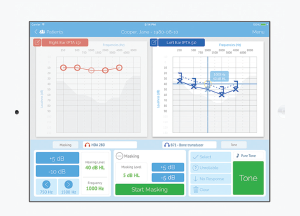
Outpatient building block at Christian Medical College in Velore, India.
Editor’s note: This article is part two of a two-part series on Dr. Yalamanchali’s medical service trip to India. Part one was published in the May 2018 issue of ENTtoday.
Explore This Issue
June 2018At the end of my research month in India, I spent my last weekend with my grandmother. For the first six years of my life, I lived in India with my grandmother while my parents completed their medical training. My grandmother and I have an unbreakable connection, and watching old age and Parkinson’s catch up with my vibrant grandmother is quite difficult.
No matter how tired she may be feeling, her greatest joy comes from feeding us, and every morning she still wakes up before sunrise to cook for the day. Over the last few years, she has complained of hearing loss and, even with my persistence, refused a formal hearing test to avoid hospitals. With the Shoebox Audiometer, she was able to undergo an audiogram in the comforts of her own home.
Portable Hearing Testing
The prevalence of disabling hearing loss is far greater today than in 1990 when the first Global Burden of Disease Study was performed. In 2015, hearing loss was the fourth-leading cause of years lived with disability. Hearing loss over time causes enormous economic and personal consequences in both children and adults. The literacy rate is worse in children with hearing loss when compared to their normal-hearing peers, with significant compromise in education attainments. Adults with hearing loss may have a sense of profound isolation and may withdraw from society and family interactions (Lancet. 2017;390:2503–2515).

Interface for the Shoebox portable audiometer.
If diagnosed early enough, 50% of hearing loss can be prevented and most of the remainder can be treated effectively, according to the WHO. An audiogram in a sound-treated booth sets the gold standard for the diagnosis of hearing loss. However, access is frequently limited by financial, geographical, and logistical constraints (J Amer Acad Audiol. 2013:24:407–416). To fill this gap, cost-effective and user-friendly alternatives such as tablet computers with calibrated headphones have been developed to perform portable audiograms outside of the conventional audio booth. These devices have been validated in different populations, ranging from children to adults, in various countries such as Brazil, Canada, and Ethiopia.
Specifically, the Shoebox portable tablet audiometer, which was used in our study, can perform interactive tests such as conditioned play audiometry and diagnostic hearing testing. Given the significant burden of chronic ear disease in South India, the goal of my project was to validate the Shoebox audiometer in the South Indian population, with the long-term goal of improving access to hearing healthcare.